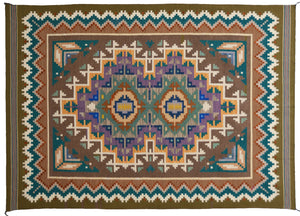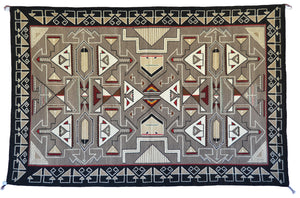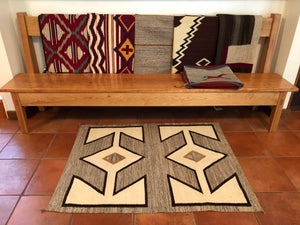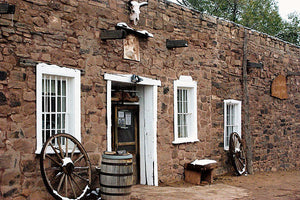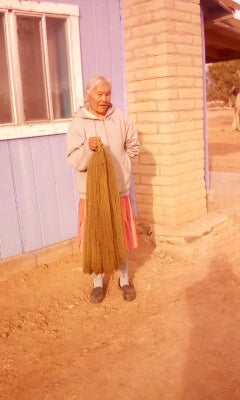From Floor to Loom - Preserving the Navajo Heritage

The Navajo Sandpainting Weaving is ranked among the Navajo tribe’s best known and best loved art forms. The original Navajo dry painting is traditionally performed for religious or medicinal purposes; it is a sacred practice. Sandpaintings are used in ceremonies designed to summon supernatural forces, they represent the Navajo’s religious world and are customarily part of ceremonies that will heal and restore a patient that is out of balance.
HASTEEN KLAH
The Navajo Sandpainting Textiles: an art form that owes its existence to Weaver, Artist, and Medicine Man Hasteen Klah (also spelled Hastiin Klah, and Hosteen Klah, 1867-1937). He began his training in the traditionally female craft of weaving with his mother and sister in the 1880s. He first began to learn the Navajo medicine ways – chanting and sandpainting – from his uncle. In learning the Nightway ceremony, Klah worked under the guidance of Laughing Singer and Tall Chanter. While most Navajo singers can master only one or two complete chants, Klah mastered at least eight. Among the ceremonies which he mastered were the Hailway, the Mountainway, the Nightway, the Windway, and the Chiricahua.
Hasteen had seen decades of unending efforts by the US Government and missionaries to transition the Navajo into the mainstream and adopt Christianity. Hasteen felt that the future of Navajo culture and religion was in danger, and yearned to preserve it.
IT BEGINS
In 1911 Hasteen Klah wove a blanket of Yei Be Chei dancers which portrayed sacred masks. Local singers felt that his was sacrilegious and demanded that Klah have a ceremony to expel the evil and that he destroy the weaving. Instead, Klah sent the weaving to Washington and experienced no negative effects.
In 1917 Klah took Franc Newcomb, trader Arthur Newcomb’s wife, to a Nightway ceremony. After the witnessing the ceremony, she became passionate about helping Klah preserve the traditions in as many media as possible. She attempted to draw from memory the designs from the sandpaintings which were used in the ceremony. She was unsuccessful and Klah sketched them for her in pencil. Newcomb then made these into watercolor reproductions and hung them in her bedroom so that the other Navajo would not be offended. After seeing that no punishment occurred, Klah then did an additional 27 paintings for her.
In 1919 Klah began to weave sandpainting rugs which were based on the chants he was qualified to sing. His first sandpainting weaving was a whirling log design from the Nightway ceremony.
Hasteen Klah with one of his Shootingway sandpainting tapestries at the Newcomb’s trading post, Navajo, New Mexico, ca. 1927. Photograph probably by Arthur or Frances Newcomb.
Over the years, Klah worked with a number of non-Indian scholars and allowed them to record his songs, ceremonies, stories, and sandpaintings. His only Navajo student – Beaal Begay – died in 1931 , so much of his knowledge of ceremony was not passed on in the Navajo traditional way. However, Klah and his nieces, Gladys and Irene, wove more than 70 sandpainting weavings between 1919 and 1937, preserving those ceremonial sandpaintings for the future.
One of the Anglos who worked with Klah was Mary Cabot Wheelwright (introduction through the Newcombs) who founded the Museum of Navajo Ceremonial Art in 1937. She had been permitted to record many of Klah’s songs and erected the museum to preserve his medicine knowledge and his sacred objects.
The museum is now known as the Wheelwright Museum. The Museum displayed many of his drawings and paintings of sand paintings, as well as his sandpainting weavings. The Wheelwright is no longer actively involved in the study of Navajo religion, however it maintains growing, world-renowned collections that document Navajo art and culture from 1850 to the present. It also presents changing exhibitions on traditional and contemporary Navajo and other Native American arts.
Getzwiller Historic Collection: Yei Be Chei : GHT 2215
This sand painting ceremony is protected by a border of arrow fletchings on all sides, Yei Dancers prepare to dance in a healing ceremony. Talking God with all of the feathers on his head wears a deer pelt as a sash and carries a weasel skin. The dancers are all male with the exception of the female with the square head in the center. The male dancers are adorned with fox tails hanging from their skirts. Calling God is seen at the other end with brown feathers on his head. All are wearing collars made of spruce.
This is an exceptional weaving and was featured in our Woven Holy People exhibit. You can see the exhibit guide here.
It is available for purchase, call Beth or Robin for pricing: 520-455-5020.
| Style | Yei / Yei Be Chei |
| Weaver | Unknown Navajo |
| Date | circa 1930s |
| Size | 5′2″ x 3′11″ (1.57M x 19M) |
| Item # | GHT 2215 |
To view all Sand Paintings available for purchase click here
- Beth Barth



